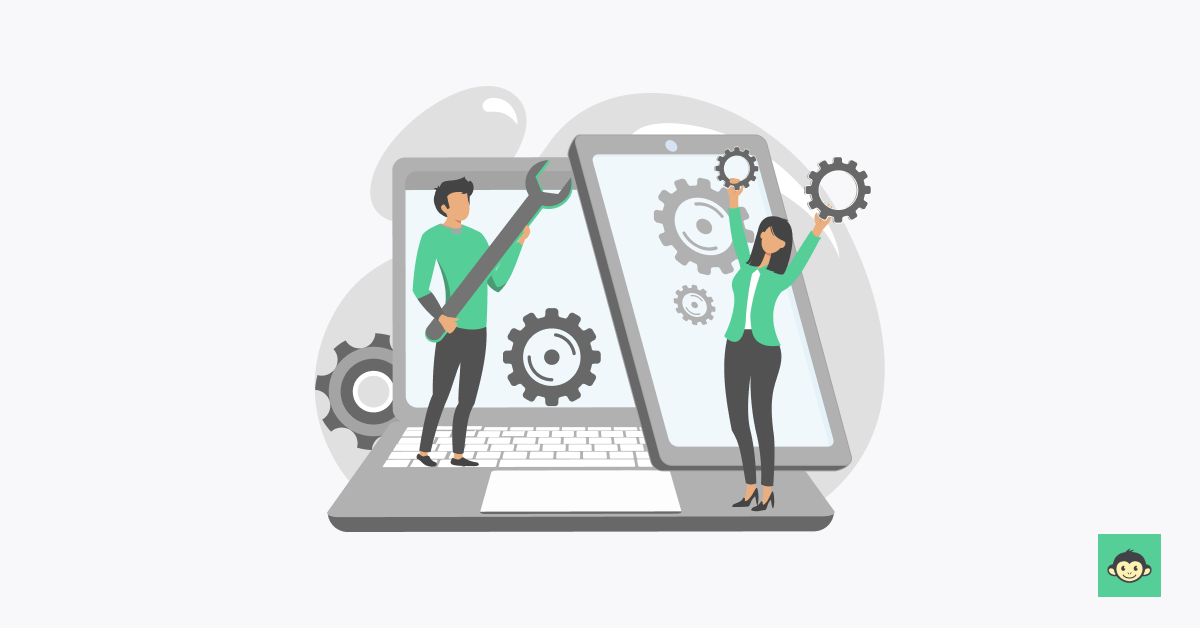Employee productivity: How it can be improved using the right employee engagement strategies?

In today's competitive business landscape, organizations strive to maximize their productivity levels to achieve success and maintain a competitive edge. In a study, it was shown that an average employee is productive for 60% or less in his work schedule. A key component in unlocking the full potential of a workforce is employee engagement.
When employees are fully engaged, they are not only motivated to perform at their best but also feel a strong sense of commitment and loyalty to their organization. This synergy between employee engagement and productivity has become a focal point for companies seeking sustainable growth and success.
In this blog, we will explore the critical link between employee productivity and employee engagement and delve into the strategies that organizations can employ to enhance productivity levels within their workforce.
By understanding the importance of employee engagement and adopting the right strategies, businesses can create a positive work environment that fosters productivity and propels their overall success.
Table of contents:-
- What does employee productivity mean?
- How is employee productivity measured?
- The difference between employee productivity and employee performance
- 7 Best strategies to boost employee productivity
- The link between employee productivity and employee engagement
- 17 Employee productivity questions to ask in your next engagement survey
- How is employee productivity directly linked to employee happiness?
- How can an employee engagement platform help you improve employee productivity?
- FAQs
What does employee productivity mean?

Employee productivity refers to the level of output and efficiency with which an employee performs their job tasks and responsibilities within a given period. It is a measure of how effectively an employee utilizes their skills, time, and resources to accomplish their work objectives.
Productivity can be evaluated in various ways, depending on the nature of the job and the organization's goals. It may involve assessing the quantity of work completed, the quality of work produced, the timeliness of task completion, or the overall impact on the organization's performance.
High employee productivity is desirable for organizations as it leads to increased efficiency, improved performance, and ultimately, higher profitability. When employees are productive, they can accomplish more in less time, meet deadlines, and contribute to the achievement of organizational goals.
Factors that influence employee productivity include:
Motivation: Employees who are motivated and engaged in their work tend to be more productive. Motivation can stem from intrinsic factors such as job satisfaction, a sense of purpose, and growth opportunities, as well as extrinsic factors like recognition, rewards, and a positive work environment.
Skills and knowledge: Employees with the necessary skills and knowledge for their roles are more likely to perform their tasks efficiently. Continuous learning and development programs can enhance employee productivity by equipping them with the relevant competencies and keeping their skills up to date.
Work environment: A conducive work environment, free from distractions and equipped with the necessary tools and resources, can significantly impact employee productivity. Factors such as workplace culture, supportive management, effective communication, and access to technology can all contribute to greater productivity levels.
Work-life balance: Balancing work responsibilities with personal life is essential for maintaining employee well-being and preventing burnout. Organizations that prioritize work-life balance and provide flexible schedules and work arrangements can help employees manage their time effectively and maintain high levels of productivity.
Clear goals and expectations: Employees need clear direction and understanding of their roles, responsibilities, and performance expectations to stay focused and productive. Setting SMART (Specific, Measurable, Achievable, Relevant, Time-bound) goals and providing regular feedback and performance evaluations can help employees stay on track.
Collaboration and teamwork: Encouraging collaboration and fostering a positive team dynamic can enhance employee productivity. Effective teamwork enables employees to share knowledge, support one another, and collectively achieve goals.
How is employee productivity measured?

Employee productivity can be measured using various methods and metrics that assess the output and efficiency of employees in performing their job tasks. These measurement techniques help organizations evaluate the effectiveness of their workforce and identify areas for improvement.
It is important to note that while these methods are commonly used, the specific approach to measuring productivity may vary based on the nature of the job and the organization's goals.
Here are some common ways in which employee productivity is measured:
Quantity of output: This method measures productivity based on the quantity of work completed by an employee within a given timeframe. It involves counting the number of units produced, tasks completed, or projects finished.
For example, in manufacturing, it could be the number of products assembled, while in sales, it could be the number of deals closed.
Time-based metrics: These metrics measure productivity by analyzing the time taken by an employee to complete specific tasks or projects. It involves tracking the time spent on different activities, such as time spent on a particular project, response time to customer inquiries, or meeting deadlines.
This method helps assess efficiency and time management skills.
Revenue or financial metrics: This approach links employee productivity to the financial performance of the organization. It involves measuring productivity based on the revenue generated, cost savings, or profitability directly attributed to the employee's efforts.
This metric is often used in sales, where individual or team sales figures are evaluated.
Key performance indicators (KPIs): KPIs are specific metrics aligned with organizational goals and objectives. They vary depending on the industry and job role.
Examples of KPIs include customer satisfaction ratings, sales targets achieved, project milestones reached, or service level agreements met. KPIs provide a comprehensive view of an employee's contribution to the organization's success.
360-degree feedback: This method involves gathering feedback from multiple sources, including supervisors, peers, subordinates, and sometimes customers or clients.
It provides a holistic view of an employee or team's productivity, incorporating different perspectives on their performance, collaboration, communication, and teamwork.
When measuring employee productivity, it is crucial to consider the context, job requirements, and individual differences. Productivity metrics should align with the organization's goals and be regularly reviewed and adjusted to ensure they remain relevant and fair.
It is essential to emphasize that measuring employee productivity should not be used as the sole determinant of an individual's value or worth. It should be accompanied by a supportive and positive work environment, feedback mechanisms, and opportunities for growth and development.
Additionally, the focus should not solely be on quantitative measures but also on qualitative factors that contribute to overall employee performance and well-being.
The difference between employee productivity and employee performance

Employee productivity and employee performance are related but distinct concepts that are often used interchangeably. However, it's important to understand the differences between the two:
Employee productivity
Employee productivity refers to the measure of output or work completed by an employee within a given period. It focuses on the quantity and efficiency of the tasks accomplished.
Productivity is typically measured by the amount of work completed, such as the number of units produced, tasks completed, or sales made.
Employee performance
Employee performance, on the other hand, is a broader concept that encompasses various factors beyond just the quantity of work. It includes the quality of work, skills, competencies, and behaviors demonstrated by an employee in their role.
Performance is measured by evaluating how well employees fulfill their job responsibilities, achieve goals, and contribute to the overall success of the organization.
In summary, productivity primarily emphasizes the output and efficiency of tasks completed, while performance encompasses a more comprehensive evaluation of an employee's abilities, effectiveness, and overall contribution to the organization.
While high productivity is often an indicator of good performance, it's possible for an employee to be productive but still exhibit poor performance if the quality or impact of their work is lacking.
To illustrate the distinction further, consider the following scenario: Employee A consistently completes a high volume of tasks within tight deadlines, demonstrating excellent productivity.
However, upon closer evaluation, it is discovered that some of the completed work contains errors and requires significant rework, indicating a drop in performance.
In this case, although productivity may be high, the overall performance is compromised due to the lack of quality and accuracy in the work.
Organizations should strive to foster both high productivity and high performance among their employees.
This can be achieved by setting clear goals, providing adequate resources and support, offering training and development opportunities, and establishing performance metrics that encompass both quantity and quality aspects of work.
By recognizing the distinction between productivity and performance, organizations can implement strategies and initiatives that promote both aspects, leading to increased efficiency, effectiveness, and overall success.
7 Best strategies to boost employee productivity

Boosting employee productivity is crucial for organizations aiming to enhance their performance and achieve their goals.
Here are seven effective strategies to improve employee productivity:
Establish clear expectations
Communicate expectations and objectives to employees. Provide them with a detailed understanding of their roles and responsibilities, as well as the specific outcomes and targets they need to achieve.
When employees have a clear understanding of what is expected of them, they are more likely to focus on tasks that contribute to overall productivity.
Provide adequate training and development
Invest in training programs and professional development opportunities for employees. By equipping them with the necessary skills and knowledge, you empower them to perform their jobs effectively.
Training can improve efficiency, enhance problem-solving abilities, and boost confidence in remote workers, leading to increased productivity.
Foster a positive work environment
Create a positive and supportive work environment that encourages collaboration, open communication, and employee well-being. Recognize and appreciate employees' efforts and achievements, as this fosters motivation and engagement.
A positive work culture promotes productivity by boosting morale, reducing stress, and increasing job satisfaction.
Encourage work-life balance
Promote a healthy work-life balance to prevent burnout and improve productivity. Encourage employees to take breaks, use vacation time, and maintain a healthy separation between work and personal life. Providing flexibility in work hours or remote work options, where feasible, can also contribute to employee well-being and increase productivity.
Streamline processes and remove obstacles
Identify and eliminate unnecessary bureaucratic procedures or obstacles that hinder productivity. Encourage employees to provide feedback on bottlenecks or inefficiencies they encounter and work collaboratively to find solutions.
Streamlining processes and minimizing unnecessary administrative tasks can free up time for employees to focus on value-adding activities.
Utilize technology and tools
Provide employees with the necessary technology, tools, and resources to perform their jobs efficiently. Automation, project management software, and communication tools can streamline workflows, facilitate collaboration, and improve overall productivity. Regularly assess and update technology to ensure it aligns with employees' needs.
Support workforce well-being
Prioritize employee well-being by implementing wellness programs, promoting work-life balance, and supporting mental and physical health initiatives.
Encourage healthy habits, such as exercise, healthy eating, and stress management. When employees feel supported and cared for, they are more likely to be engaged and productive.
Remember that every organization is unique, so it's important to assess the specific needs and dynamics of your workforce when implementing productivity-boosting strategies.
By adopting these strategies and creating a conducive environment, organizations can enhance employee productivity, drive performance, and achieve sustainable success.
The link between employee productivity and employee engagement

The link between employee productivity and employee engagement is a significant aspect of organizational success. Employee engagement refers to the level of emotional commitment and dedication employees have towards their work and the organization.
When employees are engaged, they are motivated, enthusiastic, and willing to invest their time and effort into their roles.
Here's an explanation of the link between employee productivity and employee engagement:
Motivation and effort
Engaged employees are more likely to be motivated and put forth their best effort in their work. They have a sense of purpose, feel connected to the organization's mission, and understand the impact of their contributions.
This high level of motivation leads to increased productivity as employees strive to achieve their goals and deliver quality results.
Focus and concentration
Engaged employees are focused and concentrated on their tasks. They have a sense of pride in their work and are more likely to maintain concentration, leading to improved productivity.
Engaged employees are less likely to be distracted or disengaged from their work, allowing them to perform at their best consistently.
Initiative and innovation
Employee engagement encourages employees to take initiative and contribute ideas and solutions to improve processes and outcomes. Engaged employees feel empowered to share their perspectives and are more likely to suggest innovative approaches to work.
This proactive mindset can lead to increased productivity through process improvements and creative problem-solving.
Collaboration and teamwork
Engaged employees are more willing to collaborate with their colleagues and contribute to team success. They actively seek opportunities to share knowledge, support others, and work collectively towards common goals.
This collaborative spirit enhances productivity as all employees work to leverage each other's strengths and create synergies within the team.
Resilience and adaptability
Engaged employees are more resilient in the face of challenges and change. They exhibit a positive attitude, embrace new ideas, and adapt quickly to evolving circumstances.
This resilience and adaptability enable them to maintain productivity even in dynamic or demanding work environments.
Reduced absenteeism and turnover
Employee engagement has a positive impact on reducing absenteeism and turnover rates. Engaged employees are more likely to be committed to their roles, have higher job satisfaction, and experience a greater sense of fulfillment at work.
This reduces the likelihood of absenteeism and turnover, ensuring a stable workforce and consistent productivity levels.
Organizations can foster employee engagement through various means, such as providing opportunities for growth and development, offering regular feedback and recognition, promoting a positive work culture, and ensuring open and transparent communication channels.
By encouraging employees to nurture employee engagement, organizations can create a motivated and productive workforce, leading to improved performance and overall success.
17 Employee productivity questions to ask in your next engagement survey

When designing an engagement survey to assess employee productivity, it's essential to ask the right questions to gather valuable insights.
Here are 17 questions you can include in your next engagement survey, aimed at understanding employee productivity:
- How would you rate your overall productivity in accomplishing your tasks and responsibilities?
- Do you have clear goals and objectives that align with the organization's mission and your role?
- Are you provided with the necessary resources and tools to perform your job efficiently?
- How often do you receive feedback on your work performance?
- Do you feel that your skills and abilities are effectively utilized in your current role?
- Are there any barriers or obstacles that hinder your productivity? If yes, please specify.
- Are you satisfied with the level of support and guidance you receive from your manager?
- How well do you prioritize and manage your workload?
- Do you feel encouraged to take breaks and maintain a healthy work-life balance?
- Are you provided with opportunities for professional growth and development?
- How satisfied are you with the level of collaboration and teamwork in your department?
- Do you feel that your ideas and suggestions are valued and considered by your team and organization?
- Are you aware of the impact of your work on the organization's success?
- How often do you feel engaged and motivated in your role?
- Are you given autonomy and independence in making decisions related to your work?
- How well do you adapt to changes in work processes or systems?
- Do you believe that your contributions are recognized and rewarded appropriately?
Remember, an engagement survey should include a mix of closed-ended questions with rating scales, as well as open-ended questions that allow employees to provide detailed feedback.
This combination will help you gain a comprehensive understanding of employee perceptions, identify areas for improvement, and develop strategies to enhance productivity in your organization.
How is employee productivity directly linked to employee happiness?

Employee productivity and happiness are closely intertwined in the workplace. When employees are happy, it positively impacts their productivity levels. Here's how employee productivity is directly linked to employee happiness:
- Motivation: Happy employees tend to be more motivated and engaged in their work. When employees feel satisfied and fulfilled in their roles, they are more likely to put in their best effort and strive for excellence. This increased motivation translates into higher productivity levels.
- Energy and enthusiasm: Happiness brings about positive energy and enthusiasm that can have a direct impact on productivity. Employees who are happy and content are more likely to approach their tasks with a sense of excitement and vigor, leading to increased productivity.
- Focus and concentration: When employees are happy, they experience lower levels of stress and distraction. This allows them to maintain better focus and concentration on their work. With fewer distractions and a clear mindset, employees can accomplish tasks more efficiently and effectively, thereby boosting productivity.
- Collaboration and teamwork: Employee happiness fosters a positive work environment and promotes collaboration among team members. When employees feel happy, they are more inclined to communicate, cooperate, and support each other. This collaborative atmosphere enhances productivity by facilitating smoother workflow, effective problem-solving, and shared knowledge.
- Employee retention and loyalty: Happy employees are more likely to stay with an organization for the long term. They feel a sense of loyalty and commitment, which reduces turnover rates. By retaining experienced and skilled employees, organizations can maintain productivity levels and avoid the productivity losses associated with frequent employee turnover.
- Creativity and innovation: Happiness stimulates creativity and innovation. When employees are happy, they feel more comfortable expressing their ideas, taking risks, and thinking outside the box. This creative mindset contributes to the development of innovative solutions and processes, leading to increased productivity and competitiveness.
- Customer satisfaction: Employee happiness has a direct impact on customer satisfaction. Happy employees are more likely to provide exceptional customer service, going the extra mile to meet customer needs and expectations. Satisfied customers result in repeat business, positive word-of-mouth, and increased productivity for the organization.
Employee happiness plays a vital role in driving employee productivity. By promoting a positive work environment, supporting employee well-being, and fostering a company culture full of happiness, organizations can enhance productivity levels and create a thriving workforce.
How can an employee engagement platform help you improve employee productivity?

An employee engagement platform like CultureMonkey can be a valuable tool for improving employee productivity within an organization. Here are some ways in which such a platform can contribute to enhancing productivity in the workplace:
- Communication and collaboration: An employee engagement platform provides a centralized communication hub where employees can connect, share ideas, and collaborate on projects. By facilitating seamless communication and fostering collaboration, employees can work together more efficiently, leading to increased productivity.
- Goal setting and tracking: These platforms often include features that enable employees to set individual and team goals, as well as track their progress. By having clear goals and visibility into their achievements, employees can stay focused and motivated, driving productivity.
- Recognition and rewards: Employee engagement platforms typically offer mechanisms for recognizing and rewarding employee contributions. Through peer recognition, manager feedback, and rewards programs, employees feel valued for their efforts, which boosts morale and motivates them to maintain or improve their productivity levels.
- Feedback and surveys: These platforms often include tools for conducting employee surveys and gathering feedback. By regularly seeking input from employees, organizations can identify areas for improvement and implement changes that positively impact productivity. Additionally, employees feel valued when their opinions are heard, leading to increased engagement and productivity.
- Well-being and work-life balance: Employee engagement platforms may incorporate features that promote employee well-being and work-life balance. By prioritizing employee wellness, organizations can reduce burnout and stress, which in turn enhances productivity levels. Features such as wellness challenges, mindfulness resources, and flexible scheduling options can contribute to a healthier and more productive workforce.
- Data analytics and insights: Engagement platforms often provide data analytics and reporting capabilities, offering insights into employee engagement levels, performance, and productivity metrics. By analyzing this data, organizations can identify trends, strengths, and areas for improvement. These insights can inform targeted interventions and strategies to optimize productivity.
To improve employee productivity, organizations can implement strategies such as providing employee training, and development opportunities, promoting a positive work culture, recognizing and rewarding high performance, streamlining processes, and offering appropriate incentives and benefits.
It is important to note that employee productivity should not be equated with working long hours or sacrificing work-life balance. Instead, it should focus on achieving meaningful outcomes efficiently while ensuring the well-being and engagement of employees.
FAQs
What is employee productivity, and why is it important for organizations?
Employee productivity refers to the level of output and efficiency demonstrated by employees in accomplishing their tasks and goals within a given timeframe. It is vital for organizations because higher productivity leads to increased profitability, improved customer satisfaction, and overall organizational success.
How does employee engagement impact productivity?
Employee engagement plays a crucial role in driving productivity. Engaged employees are more motivated, committed, and invested in their work. They exhibit higher levels of discretionary effort, willingly go the extra mile, and contribute innovative ideas. When employees feel valued, supported, and connected to their organization, they are more likely to perform at their best and deliver exceptional results.
What are some effective employee engagement strategies to improve productivity?
Several strategies can enhance employee engagement and, consequently, productivity. These include fostering open communication channels, providing opportunities for skill development and growth, recognizing and rewarding achievements, promoting work-life balance, offering flexible work arrangements, encouraging collaboration and teamwork, and involving employees in decision-making processes.
How can organizations measure the effectiveness of their employee engagement strategies in improving productivity?
Measuring the impact of employee engagement strategies is crucial to assess their effectiveness. Organizations can use various metrics such as employee satisfaction surveys, feedback mechanisms, performance indicators, productivity metrics, and retention rates. Regular assessments and analysis of these metrics will help organizations gauge the success of their engagement strategies and make necessary adjustments if needed.
What challenges might organizations face when implementing employee engagement strategies to improve productivity?
Implementing employee engagement strategies can come with challenges. Some common hurdles include resistance to change, lack of management support, inadequate communication, and insufficient resources. It is essential for organizations to proactively address these challenges by fostering a supportive culture, providing necessary resources, offering training and development opportunities, and ensuring clear communication and alignment throughout the organization.



